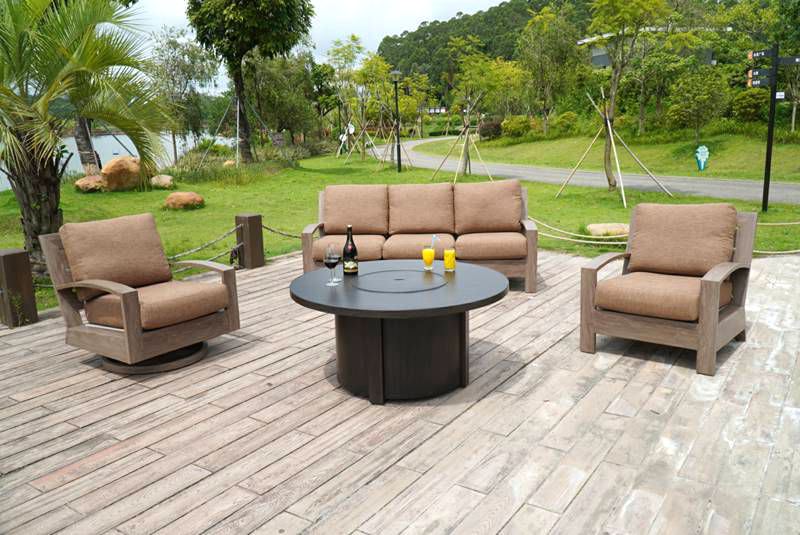aluminium garden furniture is renowned for its durability, lightweight nature, and resistance to rust. However, exposure to the elements can lead to issues like oxidation, dirt buildup, and surface stains. Proper restoration can effectively return your furniture to its former glory and extend its lifespan for many more seasons.
This step-by-step guide will walk you through the process.
What You Will Need:
Mild dish soap
Bucket of warm water
Soft-bristled brush (nylon) or non-abrasive scrubbing sponge
Microfiber cloths
White vinegar or lemon juice
Baking soda
Fine-grade (000 or 0000) steel wool (for stubborn oxidation)
Hose with spray attachment
For severely oxidized furniture: Commercial aluminium cleaner or polish (optional)
For the final protectant: Car wax with a high UV protectant or a specialised protective coating for metals
Step 1: Initial Cleaning and Inspection
Begin by thoroughly rinsing the furniture with a garden hose to remove loose dirt, dust, and debris. This prevents scratching during the scrubbing process.
Next, prepare a cleaning solution of warm water and a few drops of mild dish soap. Using a soft-bristled brush or sponge, scrub every part of the frame—paying close attention to joints, crevices, and underside surfaces where grime accumulates. For textured powder-coated surfaces, ensure you clean deep into the grooves.
Rinse thoroughly with clean water and allow the furniture to dry completely. Once dry, inspect the aluminium for the type of damage:
Surface Dirt and Grime: Easily removed with soap and water.
White Powder (Oxidation): This is a chalky, powdery substance that indicates the aluminium has reacted with oxygen.
Water Spots and Hard Water Stains: Mineral deposits left behind after evaporation.
Step 2: Addressing Oxidation and Stubborn Stains
For mild oxidation and water spots, create a paste using equal parts baking soda and water or white vinegar. Apply this paste to the affected areas and gently scrub with your soft brush or sponge. The mild acidity of vinegar or the gentle abrasion of baking soda can effectively lift stains without damaging the metal.
For more significant, powdery oxidation, you may need to use fine-grade steel wool (000 or 0000 grade). Important: Always test this in an inconspicuous area first. Gently rub the oxidized area with the grain of the metal, if visible. The fine steel wool will abrade the oxidation away without deeply scratching the underlying aluminium. Wipe away the residue with a damp cloth.
For the toughest cases, a commercial aluminium cleaner or polish can be used. Always follow the manufacturer's instructions precisely, wear gloves, and work in a well-ventilated area. These products are designed to chemically remove oxidation and restore shine.
Step 3: Final Rinsing and Drying
After treating any stains or oxidation, give the entire piece another comprehensive rinse with the hose to remove all cleaning residues. Any leftover vinegar, baking soda, or chemical cleaner could affect the next steps.
Dry the furniture meticulously with a soft, clean microfiber cloth. This step is crucial to prevent new water spots from forming before you apply a protectant.
Step 4: Protection and Prevention
The final, critical step is to protect the newly cleaned aluminium from future damage. A protective layer will shield it from UV rays, slow down oxidation, and make future cleaning easier.
A high-quality car wax with UV inhibitors is an excellent option for both raw and powder-coated aluminium. Apply a thin, even layer with a clean applicator pad according to the product directions. Once it hazes, buff it to a shine with a clean microfiber cloth.
Alternatively, you can use a spray-on protectant designed for metal outdoor furniture. This creates a clear, protective barrier.
Maintenance Tips Going Forward
Regular Cleaning: A quick wash with soapy water every few months prevents buildup.
Prompt Wiping: After rain or exposure to moisture, wiping the furniture dry can prevent water spots and slow oxidation.
Off-Season Storage: If possible, store furniture in a dry place during the winter months or prolonged periods of non-use. If left outside, use breathable, waterproof covers.
By investing a small amount of time in this restoration process, you can significantly enhance the appearance and durability of your aluminium garden furniture, ensuring it remains a stylish and functional part of your outdoor space for years to come.

Previous: